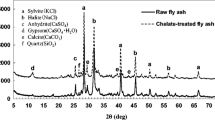Abstract
Municipal solid waste incineration (MSWI) fly ash is by-product and hazardous waste produced from MSWI plant. In the MSWI fly ash there are high contents heavy metals, among which cadmium (Cd) is more active and toxic. Although inorganic acid leaching is an effective way to remove heavy metals out from the MSWI fly ash and nitric acid has great efficiency for Cd removal, little literature reported the redistribution of remaining Cd in the MSWI fly ash. This investigation focused on the change of different factions (exchangeable, bound to carbonates, bound to Fe–Mn oxides, bound to organic matter and residual) of Cd in treated (i.e. washed with nitric acid) MSWI fly ash. Sequence extraction procedures (SEP) have been used to derive different fractions of Cd, results indicated that fractions of Cd have changed significantly after nitric acid washing procedures. Due to the changes of main compounds and microstructures stable Cd (bound to organic matter and residual) had opportunity to leach out, which resulted in a higher potential risk (or higher bioavailability index) for living creatures, although the total amount of Cd decreased. X-ray diffraction (XRD) and images of scanning electron microscope (SEM) proved these changes in washed MSWI fly ash.






Similar content being viewed by others
References
Hjelmarl O (1996) Disposal strategies for municipal solid waste incineration residues. J Hazard Mater 47:345–368
Liao WP, Yang R, Kuo WT, Huang JY (2014) The application of electrocoagulation for the conversion of MSWI fly ash into nonhazardous materials. J Environ Manag 137:157–162
Yang R, Liao WP, Wu PH (2012) Basic characteristics of leachate produced by various washing processes for MSWI ashes in Taiwan. J Environ Manag 104:67–76
Herck PV, Bruggen BVD, Vogels G, Vandecasteele C (2000) Application of computer modelling to predict the leaching behaviour of heavy metals from MSWI fly ash and comparison with a sequential extraction method. Waste Manag 20:203–210
Lin X, Yan M, Dai A, Zhan M, Fu J, Li X, Chen T, Lu S, Buekens A, Yan J (2015) Simultaneous suppression of PCDD/F and NO(x) during municipal solid waste incineration. Chemosphere 126:60–66
Takaoka M, Shiono A, Yamamoto T, Uruga T, Takeda N, Tanaka T, Oshita K, Matsumoto T, Harada H (2008) Relationship between dynamic change of copper and dioxin generation in various fly ash. Chemosphere 73:S78–S83
del Valle-Zermeno R, Formosa J, Chimenos JM, Martinez M, Fernandez AI (2013) Aggregate material formulated with MSWI bottom ash and APC fly ash for use as secondary building material. Waste Manag 33:621–627
Haiying Z, Youcai Z, Jingyu Q (2011) Utilization of municipal solid waste incineration (MSWI) fly ash in ceramic brick: product characterization and environmental toxicity. Waste Manag 31:331–341
Tan W-F, Wang L-A, Huang C, Liu Y-Y, Green JE, Newport D, Green T (2012) Utilization of municipal solid waste incineration fly ash in lightweight aggregates. J Central South Univ 19:835–841
Bayuseno AP, Schmahl WW (2011) Characterization of MSWI fly ash through mineralogy and water extraction. Resour Conserv Recycl 55:524–534
Huang K, Inoue K, Harada H, Kawakita H, Ohto K (2011) Leaching behavior of heavy metals with hydrochloric acid from fly ash generated in municipal waste incineration plants. Trans Nonferr Metals Soc China 21:1422–1427
Ettler V, Vrtiskova R, Mihaljevic M, Sebek O, Grygar T, Drahota P (2009) Cadmium, lead and zinc leaching from smelter fly ash in simple organic acids—simulators of rhizospheric soil solutions. J Hazard Mater 170:1264–1268
Zhang HY, Ma GX (2012) Leaching of heavy metals from municipal solid waste incineration (MSWI) fly ash using nitric acid. Appl Mech Mater 249–250:918–921
Tessier A, Campbell PGC, Bisson M (1979) Sequential extraction procedure for the speciation of particulate trace metals. Anal Chem 51:844–851
Hong KJ, Tokunaga S, Ishigami Y, Kajiuchi T (2000) Extraction of heavy metals from MSW incinerator fly ash using saponins. Chemosphere 41:345–352
Sheng Y (2013) Study on the leaching of heavy metals of solid waste incineration fly ash. Chongqing University, Chongqing (in Chinese)
Chou JD, Wey MY, Chang SH (2009) Evaluation of the distribution patterns of Pb, Cu and Cd from MSWI fly ash during thermal treatment by sequential extraction procedure. J Hazard Mater 162:1000–1006
Gomes Pattiyage IA, Asaeda Takashi (2009) Phycoremediation of Chromium (VI) by Nitella and impact of calcium encrustation. J Hazard Mater 166:1332–1338
Gomes Pattiyage IA, Asaeda Takashi (2013) Phytoremediation of heavy metals by calcifying macro-algae (Nitella pseudoflabellata): implications of redox insensitive end products. Chemosphere 92:1328–1334
Hakanson L (1980) An ecological risk index for aquatic pollution control. Water Res 14:975–1001
Pan Y, Wu Z, Zhou J, Zhao J, Ruan X, Liu J, Qian G (2013) Chemical characteristics and risk assessment of typical municipal solid waste incineration (MSWI) fly ash in China. J Hazard Mater 261:269–276
Wang Y, Pan Y, Zhang L, Yue Y, Zhou J, Xu Y, Qian G (2015) Can washing-pretreatment eliminate the health risk of municipal solid waste incineration fly ash reuse? Ecotoxicol Environ Saf 111:177–184
Alexander J, Benford D, Cockburn A, Cravedi J-P, Dogliotti E, Domenico AD, Férnandez-Cruz ML, Peter Fürst JF-G, Galli CL, Grandjean P, Gzyl J, Heinemeyer G, Johansson N, Mutti A, Schlatter J, Leeuwen RV, Van Peteghem C, Verger P (2009) Cadmium in food scientific opinion of the panel on contaminants in the food chain. Eur Food Saf Auth 980:1–139
Bernhoft RA (2013) Cadmium toxicity and treatment. Sci World J 2013:394652
Ludwig B, Khanna P, Prenzel J, Beese F (2005) Heavy metal release from different ashes during serial batch tests using water and acid. Waste Manag 25:1055–1066
Author information
Authors and Affiliations
Corresponding author
Rights and permissions
About this article
Cite this article
Zhao, X., Wang, La., Wang, L. et al. Distribution of remaining Cd in MSWI fly ash washed with nitric acid. J Mater Cycles Waste Manag 19, 1415–1422 (2017). https://doi.org/10.1007/s10163-016-0535-7
Received:
Accepted:
Published:
Issue Date:
DOI: https://doi.org/10.1007/s10163-016-0535-7




